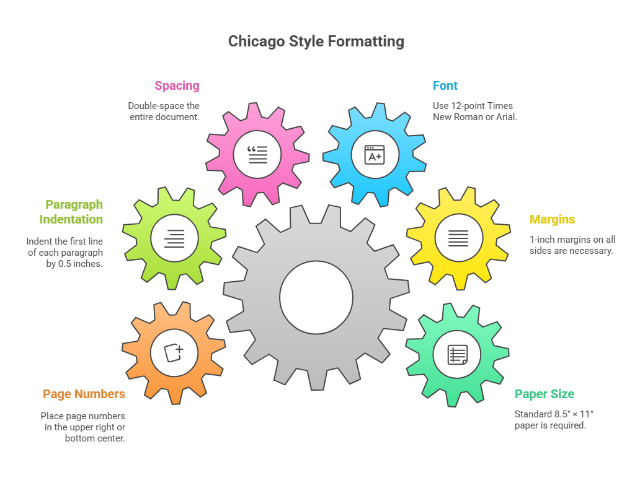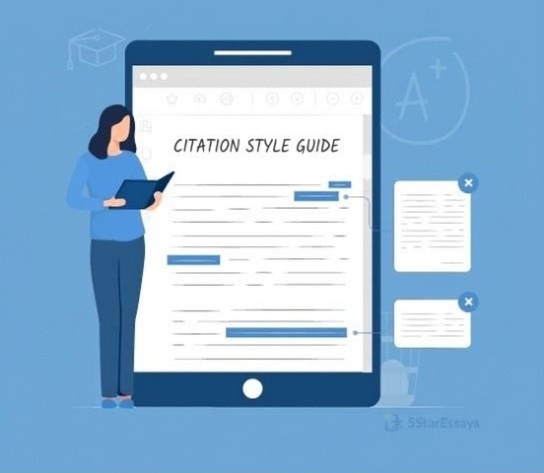Chicago Style Paper Formatting Basics
General Formatting Requirements
Chicago style papers follow specific formatting guidelines regardless of which citation system you use. Your paper should use standard 8.5" × 11" paper with 1-inch margins on all sides. Use a readable 12-point font like Times New Roman or Arial throughout the entire document, including footnotes and endnotes.
Double-space your entire paper, including block quotations, notes, and the bibliography or reference list. Indent the first line of each paragraph by 0.5 inches using the Tab key. Page numbers should appear in the upper right corner or centered at the bottom, starting with the first page of text (not the title page).

Title Page Format
Chicago style requires a title page that includes your paper title, author name, course information, instructor name, and date. Center all information vertically and horizontally on the page. Place your title approximately one-third down the page, followed by your name, course details, and submission date.
The title page does not receive a page number. Begin numbering on the first page of text as page 1. If your instructor doesn't require a title page, place your name, instructor name, course, and date in the upper left corner of the first page, then center your title below this information.
Headings and Subheadings
Chicago style doesn't prescribe specific heading levels like MLA style, but recommends consistency. Use a clear hierarchy with different formatting for each level: centered, bold, flush left, or indented. First-level headings might be centered and bold, second-level headings flush left and bold, and third-level headings flush left and italicized.
Maintain parallel structure in your headings. If one heading uses a noun phrase, use noun phrases for all headings at that level. Skip a line before each heading but not after. Number sections and subsections if required by your discipline or instructor.
Notes-Bibliography System
Understanding Footnotes and Endnotes
The Notes-Bibliography system is Chicago's traditional citation method, preferred in history, literature, and arts. Each citation appears as a superscript number in your text that corresponds to a footnote at the bottom of the page or an endnote at the end of the paper. Notes provide complete publication information for sources and can include commentary or additional context.
Footnotes appear at the bottom of each page where citations occur, separated from the main text by a short horizontal line. Endnotes appear on a separate page titled "Notes" before your bibliography. Choose either footnotes or endnotes—not both—unless your instructor specifies otherwise. Footnotes are generally preferred because they're more convenient for readers.
Creating Footnotes
Number footnotes consecutively throughout your paper using superscript Arabic numerals (1, 2, 3). Place the superscript number at the end of the sentence, after punctuation, with no space before it. In your word processor, use the automatic footnote function rather than manually typing superscript numbers.
The first citation of a source requires complete bibliographic information. Format footnotes with the author's name in normal order (first name, last name), followed by the source title, publication information in parentheses, and page numbers.
First footnote citation - Book:
Margaret Mitchell, Gone with the Wind (New York: Macmillan, 1936), 45.
First footnote citation - Journal article:
James Baldwin, "Stranger in the Village," Harper's Magazine, October 1953, 42-48.
First footnote citation - Website:
National Archives, "Declaration of Independence," accessed November 15, 2024, https://www.archives.gov/founding-docs/declaration.
Shortened Footnotes
After the first full citation, use shortened footnotes for subsequent references to the same source. Include only the author's last name and page number. If you cite multiple works by the same author, include a shortened title.
Shortened footnote: 4. Mitchell, 127.
Shortened footnote with title: 5. Mitchell, Gone with the Wind, 127.
If you're citing the same source repeatedly in consecutive notes, you may use "Ibid." (meaning "in the same place") with the page number. However, the Chicago Manual of Style 18th edition discourages overusing Ibid., preferring shortened notes instead.
APA? MLA? Chicago? We Handle Them All
Complex Citation Requirements? Our Writers Are Style Guide Experts
Get Expert Writing Help
No more second-guessing commas, italics, or formatting. Get papers written and cited correctly by professionals who live and breathe style guides
APA? MLA? Chicago? We Handle Them All
Complex Citation Requirements? Our Writers Are Style Guide Experts
No more second-guessing commas, italics, or formatting. Get papers written and cited correctly by professionals who live and breathe style guides
Bibliography Format
Your bibliography appears at the end of your paper on a separate page titled "Bibliography" or "Works Cited." List all sources alphabetically by author's last name. Use hanging indentation—the first line flush left, subsequent lines indented 0.5 inches.
Bibliography entries differ from footnotes in three key ways: author names are inverted (last name first), elements are separated by periods instead of commas, and publication information isn't enclosed in parentheses.
Bibliography entry - Book:
Mitchell, Margaret. Gone with the Wind. New York: Macmillan, 1936.
Bibliography entry - Journal article:
Baldwin, James. "Stranger in the Village." Harper's Magazine, October 1953,
42-48.
Bibliography entry - Website:
National Archives. "Declaration of Independence." Accessed November 15,
2024. https://www.archives.gov/founding-docs/declaration.
Author-Date System
Understanding Author-Date Citations
The Author-Date system resembles APA format and is preferred in social sciences, sciences, and some humanities disciplines. Instead of footnotes, you place brief parenthetical citations in your text that refer readers to full entries in your reference list. This system emphasizes publication dates, making it ideal for fields where currency of research matters.
In-text citations include the author's last name and publication year, separated by a comma, enclosed in parentheses. Add page numbers for direct quotations or specific references, preceded by a comma.
Parenthetical citation - General reference: Recent studies confirm this trend (Johnson 2023).
Parenthetical citation - Direct quote: As one researcher notes, "Climate patterns have shifted significantly" (Johnson 2023, 78).
Parenthetical citation - Multiple authors: This finding has been replicated (Smith and Brown 2022, 45-47).
Integrating Author-Date Citations
When the author's name appears in your sentence, include only the year in parentheses immediately after the name. Place page numbers at the end of the sentence if quoting directly.
Author in text: Johnson (2023) argues that environmental factors play a crucial role.
Author in text with quote: According to Johnson (2023, 78), "Climate patterns have shifted significantly."
For sources with three or more authors, use "et al." after the first author's name in citations, but list all authors in the reference list entry.
Three or more authors: The research team found significant correlations (Martinez et al. 2024, 112).
Reference List Format
Your reference list appears at the end of your paper on a separate page titled "References." List entries alphabetically by author's last name using hanging indentation. The Author-Date reference list format differs slightly from Notes-Bibliography formatting, particularly for articles and books.
Reference list - Book:
Mitchell, Margaret. 1936. Gone with the Wind. New York: Macmillan.
Reference list - Journal article:
Baldwin, James. 1953. "Stranger in the Village." Harper's Magazine, October,
42-48.
Reference list - Website:
National Archives. 2024. "Declaration of Independence." Accessed November
15, 2024. https://www.archives.gov/founding-docs/declaration.
Notice the year comes immediately after the author name in Author-Date format, while in Notes-Bibliography it appears at the end. This placement emphasizes publication date relevance in scientific research.
Choosing Between Chicago Systems
Discipline-Based Selection
Your academic discipline typically determines which Chicago system to use. History, art history, music, literature, and philosophy traditionally use Notes-Bibliography because extensive footnotes allow for detailed commentary and source discussion. These fields value narrative flow, and parenthetical citations would disrupt textual analysis.
Social sciences like anthropology, political science, and sociology often prefer Author-Date because it aligns with APA style conventions in related fields. Natural sciences and business disciplines also favor Author-Date for its emphasis on publication dates and compatibility with citation management software.
Professor and Publication Requirements
Always check your assignment guidelines or ask your instructor which Chicago system they prefer. Some professors accept either system, while others have strict requirements. Graduate programs and thesis committees usually specify which system to use consistently throughout your work.
If you're submitting to a journal or conference, consult their style guide or recent publications. Many academic journals specify citation systems in their submission guidelines. When in doubt, look at recently published articles in your field or consult our citation styles comparison to understand disciplinary norms.
Practical Considerations
Notes-Bibliography offers more flexibility for adding explanatory comments alongside citations. If your paper requires extensive commentary, source discussion, or tangential information that would disrupt your main text, footnotes provide an elegant solution. Author-Date works better for papers with numerous brief citations where publication dates matter most.
Citation management software like Zotero, Mendeley, and EndNote supports both the Chicago systems, but Author-Date may be slightly easier to manage in collaborative research. Notes-Bibliography requires more careful formatting attention, especially if converting between footnotes and endnotes or adjusting superscript numbers.
Running Out of Time?
Need a Perfectly Cited Paper Fast? We Deliver Quality Under Pressure
Tight deadline? Don't sacrifice citation quality. Our writers deliver properly formatted, thoroughly researched papers when you need them
Turabian Style Explained
What Is Turabian Style?
Turabian style is a student-focused adaptation of the Chicago style created by Kate L. Turabian, a dissertation secretary at the University of Chicago. Her manual, A Manual for Writers of Research Papers, Theses, and Dissertations, now in its 9th edition, simplifies Chicago guidelines for academic writing below the publication level.
Turabian follows Chicago's core principles but offers more concise rules and focuses on elements relevant to student papers. It includes both Notes-Bibliography and Author-Date systems, making the same discipline-based recommendations as Chicago. Most universities accept Turabian for theses and dissertations, though some require strict Chicago Manual adherence.
Key Differences from Chicago
Turabian and Chicago share the same fundamental citation formats, but Turabian simplifies some presentation details. Turabian offers more guidance on research paper structure, including abstract formatting, table of contents, and appendix organization. It provides clearer instructions for formatting thesis and dissertation elements.
Chicago style is designed for published works and professional manuscripts, while Turabian addresses academic papers, theses, and dissertations. If your instructor says "use Chicago style," they usually accept either Turabian or Chicago—both produce nearly identical citations. For undergraduate and graduate papers, Turabian's focused approach may be more practical.

8 Common Chicago Style Format Errors
1. Mixing Citation Systems
Incorrect: Using footnotes in some sections and Author-Date citations in others.
Correct: Choose one system—Notes-Bibliography or Author-Date—and use it consistently throughout your entire paper.
Why it matters: Mixing systems confuses readers and violates Chicago style guidelines. Each system has distinct formatting rules that cannot be combined.
2. Incorrect Footnote Punctuation
Incorrect:
Mitchell, Margaret, Gone with the Wind, New York: Macmillan, 1936, 45.
Correct:
Margaret Mitchell, Gone with the Wind (New York: Macmillan, 1936), 45.
Why it matters: Notes-Bibliography footnotes use commas between elements but place publication information in parentheses, not separated by commas.
3. Wrong Author Name Order
Incorrect Bibliography:
Margaret Mitchell. Gone with the Wind. New York: Macmillan, 1936.
Correct Bibliography:
Mitchell, Margaret. Gone with the Wind. New York: Macmillan, 1936.
Why it matters: Bibliography entries invert the first author's name (last, first) for alphabetical sorting, while footnotes use normal order (first last).
4. Missing Access Dates for Websites
Incorrect:
National Archives, "Declaration of Independence,"
https://www.archives.gov/founding-docs/declaration.
Correct:
National Archives, "Declaration of Independence," accessed November 15,
2024, https://www.archives.gov/founding-docs/declaration.
Why it matters: Chicago requires access dates for online sources because web content changes. Include the date you viewed the material.
5. Incorrect Title Capitalization
Incorrect:
Mitchell, Margaret. Gone With The Wind. New York: Macmillan, 1936.
Correct:
Mitchell, Margaret. Gone with the Wind. New York: Macmillan, 1936.
Why it matters: Chicago uses headline-style capitalization (capitalize major words) for titles in English. Lowercase articles, prepositions, and conjunctions unless they're the first word.
6. Improper Shortened Note Format
Incorrect:
Mitchell, Margaret, Gone with the Wind, 127.
Correct:
Mitchell, 127.
Why it matters: After the first full citation, shortened notes include only last name and page number. Don't repeat the full citation or add unnecessary elements.
7. Wrong Hanging Indent Format
Incorrect:
Bibliography entries with first-line indentation or no indentation.
Correct:
First line flush left, subsequent lines indented 0.5 inches (hanging indent).
Why it matters: Hanging indents make author names stand out for easy alphabetical scanning. This formatting is essential for professional presentation.
Still Learning the Ropes?
Master Your Subject, Not Citation Manuals Get Expertly Formatted Papers
Let citation experts handle the technical details while you focus on learning and understanding your coursework. Smart students delegate smartly
8. Confusing Author-Date and Notes-Bibliography Reference Formats
Incorrect Reference List:
Mitchell, Margaret. Gone with the Wind. New York: Macmillan, 1936.
Correct Reference List:
Mitchell, Margaret. 1936. Gone with the Wind. New York: Macmillan.
Why it matters: Author-Date places the year immediately after the author name, while Notes-Bibliography places it at the end. Each system has distinct formatting rules.
Chicago Manual of Style 18th Edition Updates
Key Changes from 17th Edition
The Chicago Manual of Style 18th edition, published in 2024, introduced several important updates reflecting digital publishing realities and evolving scholarly practices. The new edition simplified URL formatting, removing the requirement to include "http://" or "https://" prefixes in citations. Chicago now recommends including full URLs but accepts shortened, stable links when appropriate.
The 18th edition expanded guidance on citing social media, multimedia content, and data sets. It provides clearer instructions for citing TikTok videos, Instagram posts, podcasts, and YouTube content—sources increasingly important in contemporary research. The manual also updated recommendations for citing streaming services, online video, and digital archives.
Inclusive Language Updates
The Chicago 18th edition emphasizes inclusive language, particularly regarding gender-neutral pronouns. The manual now fully endorses singular "they" as a gender-neutral pronoun in formal writing. It provides guidance on respecting individuals' pronoun preferences in scholarly work and citations.
The edition expanded the discussion of conscious language choices, encouraging writers to consider alternatives to potentially exclusionary or biased terms. While Chicago doesn't mandate specific terminology, it encourages thoughtful language that respects diverse audiences and subjects.
Digital Publication Guidance
The 18th edition recognizes that many sources exist only digitally, eliminating the former distinction between print and electronic versions when citing online journal articles. If a source is published online, simply cite it as is without noting "online version" or similar qualifications.
Chicago now provides clearer guidance for citing preprint servers, open-access repositories, and digital-first publications. The manual acknowledges that much scholarly communication happens through blog posts, Twitter threads, and online forums, providing citation formats for these contemporary sources.
Free Downloadable Resources
Master Chicago Style Formatting
Chicago style format remains one of the most flexible and comprehensive citation systems available, accommodating different research needs across academic disciplines. Whether you choose Notes-Bibliography for your history seminar or Author-Date for your sociology research, understanding Chicago's core principles ensures your work meets professional scholarly standards.
The key to mastering Chicago style lies in consistency and attention to detail. Choose one system at the start of your project and apply it throughout. Use our templates and resources to maintain proper formatting, and don't hesitate to consult our citation style guide for complex citations.
Struggling With Reference Pages? We'll Format Them Perfectly
Stop Wrestling With Hanging Indents, Italics, and Punctuation—Get Professional Citation Formatting
- Submit your sources (articles, books, websites, etc.)
- Specify your required citation style
- Our specialists format each entry correctly
- Get a perfectly organized reference list
Every entry alphabetized, every detail correct, every professor impressed. That's our guarantee.
Get Perfect References










